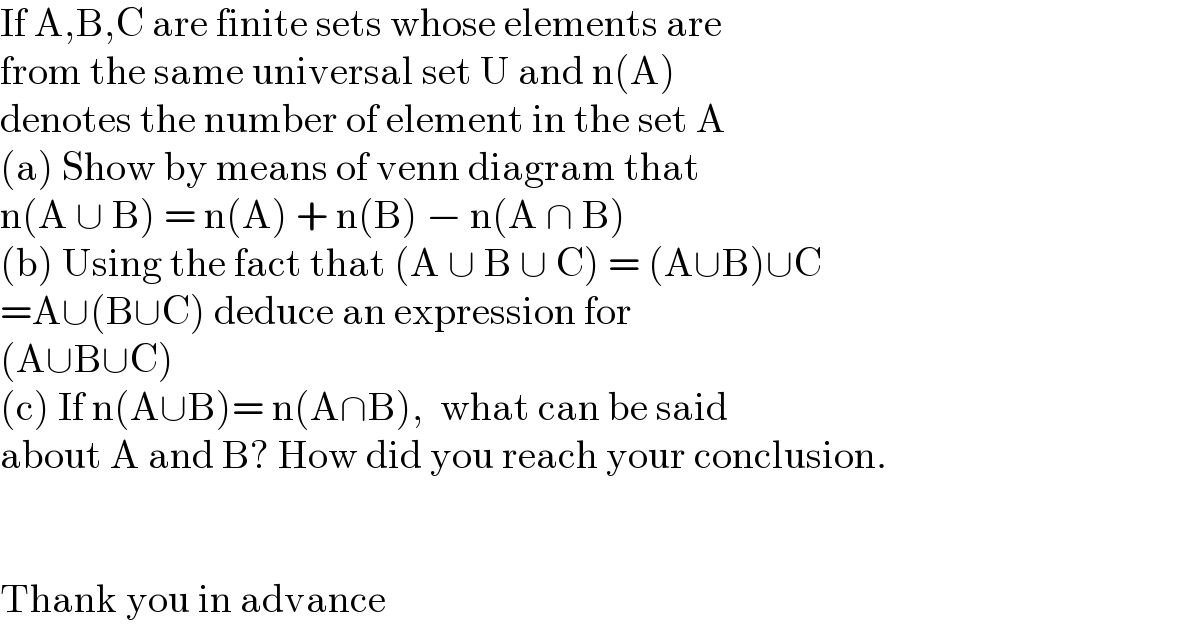
Question Number 203545 by Mastermind last updated on 21/Jan/24

$$\mathrm{If}\:\mathrm{A},\mathrm{B},\mathrm{C}\:\mathrm{are}\:\mathrm{finite}\:\mathrm{sets}\:\mathrm{whose}\:\mathrm{elements}\:\mathrm{are}\: \\ $$$$\mathrm{from}\:\mathrm{the}\:\mathrm{same}\:\mathrm{universal}\:\mathrm{set}\:\mathrm{U}\:\mathrm{and}\:\mathrm{n}\left(\mathrm{A}\right)\: \\ $$$$\mathrm{denotes}\:\mathrm{the}\:\mathrm{number}\:\mathrm{of}\:\mathrm{element}\:\mathrm{in}\:\mathrm{the}\:\mathrm{set}\:\mathrm{A} \\ $$$$\left(\mathrm{a}\right)\:\mathrm{Show}\:\mathrm{by}\:\mathrm{means}\:\mathrm{of}\:\mathrm{venn}\:\mathrm{diagram}\:\mathrm{that} \\ $$$$\mathrm{n}\left(\mathrm{A}\:\cup\:\mathrm{B}\right)\:=\:\mathrm{n}\left(\mathrm{A}\right)\:+\:\mathrm{n}\left(\mathrm{B}\right)\:−\:\mathrm{n}\left(\mathrm{A}\:\cap\:\mathrm{B}\right) \\ $$$$\left(\mathrm{b}\right)\:\mathrm{Using}\:\mathrm{the}\:\mathrm{fact}\:\mathrm{that}\:\left(\mathrm{A}\:\cup\:\mathrm{B}\:\cup\:\mathrm{C}\right)\:=\:\left(\mathrm{A}\cup\mathrm{B}\right)\cup\mathrm{C} \\ $$$$=\mathrm{A}\cup\left(\mathrm{B}\cup\mathrm{C}\right)\:\mathrm{deduce}\:\mathrm{an}\:\mathrm{expression}\:\mathrm{for} \\ $$$$\left(\mathrm{A}\cup\mathrm{B}\cup\mathrm{C}\right) \\ $$$$\left(\mathrm{c}\right)\:\mathrm{If}\:\mathrm{n}\left(\mathrm{A}\cup\mathrm{B}\right)=\:\mathrm{n}\left(\mathrm{A}\cap\mathrm{B}\right),\:\:\mathrm{what}\:\mathrm{can}\:\mathrm{be}\:\mathrm{said} \\ $$$$\mathrm{about}\:\mathrm{A}\:\mathrm{and}\:\mathrm{B}?\:\mathrm{How}\:\mathrm{did}\:\mathrm{you}\:\mathrm{reach}\:\mathrm{your}\:\mathrm{conclusion}. \\ $$$$ \\ $$$$ \\ $$$$\mathrm{Thank}\:\mathrm{you}\:\mathrm{in}\:\mathrm{advance} \\ $$
Answered by deleteduser1 last updated on 21/Jan/24
![b) n∣(A∪B)∪C∣=n[P∪C] where P=A∪B n(P∪C)=n(P)+n(C)−n(P∩C) =n(A)+n(B)+n(C)−n(A∩B)−n(P∩C) P∩C=(A∩B)∩C=(A∩C)∪(B∩C) n(PnC)=n(A∩C)+n(B∩C)−n[(A∩C)∩(B∩C)] ⇒n(A∪B∪C)=n(A)+n(B)+(C)−n(A∩B) −n(A∩C)−n(B∩C)+n(A∩B∩C) c) Suppose one of the sets ,say A, is not a subset of the other,B. Then,∃ a_1 ∈A s.t. a_1 ∉B ⇒n(A∪B)>n(A∩B)⇒A⊆B⇒n(A∩B)=n(A) Suppose B\A ≠∅⇒n(B\A)=k≥1 then n(A∪B)=n(A)+n(B)−n(A∩B)=n(B) =n(B\A)+n(A)=k+n(A)>n(A∩B) ⇒n(B\A)=∅⇒A=B](Q203548.png)
$$\left.{b}\right)\:{n}\mid\left({A}\cup{B}\right)\cup{C}\mid={n}\left[{P}\cup{C}\right]\:{where}\:{P}={A}\cup{B} \\ $$$${n}\left({P}\cup{C}\right)={n}\left({P}\right)+{n}\left({C}\right)−{n}\left({P}\cap{C}\right) \\ $$$$={n}\left({A}\right)+{n}\left({B}\right)+{n}\left({C}\right)−{n}\left({A}\cap{B}\right)−{n}\left({P}\cap{C}\right) \\ $$$${P}\cap{C}=\left({A}\cap{B}\right)\cap{C}=\left({A}\cap{C}\right)\cup\left({B}\cap{C}\right) \\ $$$${n}\left({PnC}\right)={n}\left({A}\cap{C}\right)+{n}\left({B}\cap{C}\right)−{n}\left[\left({A}\cap{C}\right)\cap\left({B}\cap{C}\right)\right] \\ $$$$\Rightarrow{n}\left({A}\cup{B}\cup{C}\right)={n}\left({A}\right)+{n}\left({B}\right)+\left({C}\right)−{n}\left({A}\cap{B}\right) \\ $$$$−{n}\left({A}\cap{C}\right)−{n}\left({B}\cap{C}\right)+{n}\left({A}\cap{B}\cap{C}\right) \\ $$$$ \\ $$$$\left.{c}\right)\:{Suppose}\:{one}\:{of}\:{the}\:{sets}\:,{say}\:{A},\:{is}\:{not}\:{a}\:{subset} \\ $$$${of}\:{the}\:{other},{B}.\:{Then},\exists\:{a}_{\mathrm{1}} \in{A}\:{s}.{t}.\:{a}_{\mathrm{1}} \notin{B} \\ $$$$\Rightarrow{n}\left({A}\cup{B}\right)>{n}\left({A}\cap{B}\right)\Rightarrow{A}\subseteq{B}\Rightarrow{n}\left({A}\cap{B}\right)={n}\left({A}\right) \\ $$$${Suppose}\:{B}\backslash{A}\:\neq\emptyset\Rightarrow{n}\left({B}\backslash{A}\right)={k}\geqslant\mathrm{1} \\ $$$$\:{then}\:{n}\left({A}\cup{B}\right)={n}\left({A}\right)+{n}\left({B}\right)−{n}\left({A}\cap{B}\right)={n}\left({B}\right) \\ $$$$={n}\left({B}\backslash{A}\right)+{n}\left({A}\right)={k}+{n}\left({A}\right)>{n}\left({A}\cap{B}\right) \\ $$$$\Rightarrow{n}\left({B}\backslash{A}\right)=\emptyset\Rightarrow{A}={B} \\ $$
Commented by Mastermind last updated on 21/Jan/24

$$\mathrm{Thank}\:\mathrm{you}\:\mathrm{but}\:\mathrm{whats}\:\mathrm{the}\:\mathrm{meaning}\:\mathrm{of}\:\mathrm{s}.\mathrm{t}.\:? \\ $$
Commented by Mastermind last updated on 21/Jan/24

$$\mathrm{besides}\:\mathrm{i}\:\mathrm{could}\:\mathrm{not}\:\mathrm{identify}\:\mathrm{solution}\:\mathrm{a}\:\mathrm{and}\:\mathrm{solution}\:\mathrm{b} \\ $$
Commented by deleteduser1 last updated on 21/Jan/24

$${such}\:{that} \\ $$
Commented by Mastermind last updated on 21/Jan/24

$$\mathrm{Thank}\:\mathrm{you}\:\mathrm{but}\:\mathrm{help}\:\mathrm{me}\:\mathrm{separate}\:\mathrm{the}\:\mathrm{solution} \\ $$$$\mathrm{separately}. \\ $$$$ \\ $$$$\mathrm{Thank}\:\mathrm{you} \\ $$
Commented by Mastermind last updated on 21/Jan/24

$$\mathrm{Where}\:\mathrm{is}\:\mathrm{the}\:\mathrm{solution}\:\mathrm{A}\:? \\ $$
